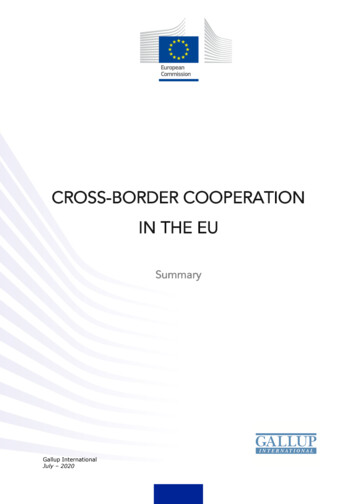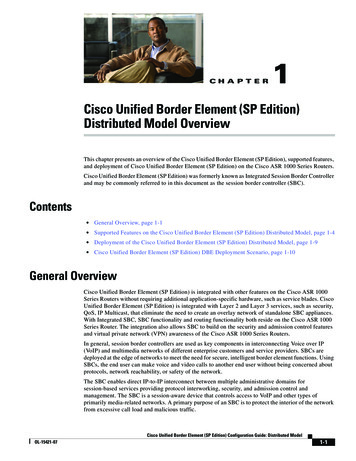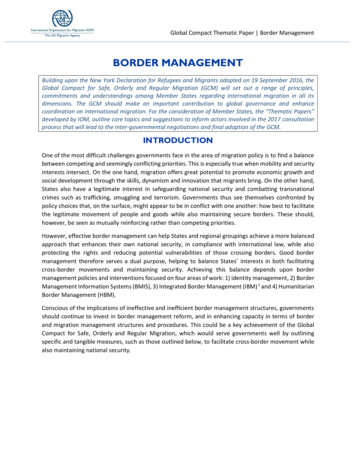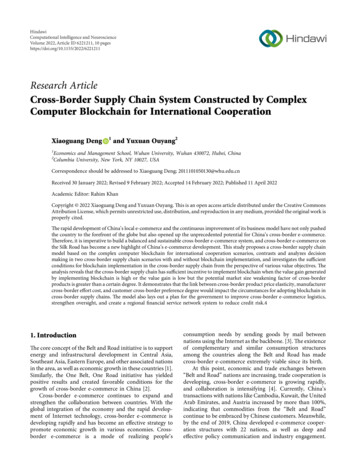
Transcription
CROSS-BORDER COOPERATIONIN THE EUSummaryGallup InternationalJuly – 2020
CROSS-BORDER COOPERATION IN THE EU 2020EUROPEAN COMMISSIONDirectorate-General for Regional and Urban PolicyDirectorate European Territorial Cooperation, Macro-regions, Interreg and Programme Implementation IUnit D2 – Interreg, Cross-Border Cooperation, internal bordersContact: Nathalie Verschelde, Egle SpudulyteE-mail: pean CommissionB-1049 Brussels
EUROPEAN COMMISSIONCROSS-BORDER COOPERATIONIN THE EU“The information and views set out in this summary are those of the author(s) and do notnecessarily reflect the official opinion of the Commission. The Commission does notguarantee the accuracy of the data included in this study. Neither the Commission nor anyperson acting on the Commission’s behalf may be held responsible for the use which may bemade of the information contained therein.”Directorate-General for Regional and Urban Policy2020EN
CROSS-BORDER COOPERATION IN THE EU 2020Europe Direct is a service to help you find answersto your questions about the European Union.Freephone number (*):00 800 6 7 8 9 10 11(*)The information given is free, as are most calls (though some operators, phoneboxes or hotels may charge you).Manuscript completed in July 2020The European Commission is not liable for any consequence stemming from the reuse of this publication.Luxembourg: Publications Office of the European Union, 2020ISBNdoi European Union, 2020Reuse is authorised provided the source is acknowledged.The reuse policy of European Commission documents is regulated by Decision 2011/833/EU (OJ L 330,14.12.2011, p. 39).
CROSS-BORDER COOPERATION IN THE EU 2020TABLE OF CONTENTSI.Introduction 7II.Awareness of EU regional policy-funded cross-border cooperation activities 10III.CROSS BORDER MOBILITY BETWEEN COUNTRIES COVERED BY AN INTERREGCROSS-BORDER COOPERATION PROGRAMME 153.1GOING ABROAD TO OTHER COUNTRIES 153.2MOBILITY OF CITIZENS WITHIN AN INTERREG CROSS-BORDER COOPERATIONPROGRAMME 183.3a)b)c)d)e)THE REASONS FOR CROSS-BORDER MOBILITY 20Travel for leisure activities including tourismTravel to shop for goods or services (for example buying clothes or to visit a hairdresser)Travel to visit friendsTravel for work or business purposesTravel to visit family2021212222IV.CROSS BORDER EXPERIENCE: ATTITUDES TOWARDS SPECIFIC SOCIALCATEGORIES FROM NEIGHBOURING COUNTRIES 234.1COMFORT WITH HAVING CERTAIN SOCIAL RELATIONS WITH PEOPLE FROMNEIGHBOURING COUNTRIES 23a)b)c)d)4.2NeighboursWork colleagueFamily memberManager24242525GENERAL LEVEL OF SOCIAL TRUST IN OTHER PEOPLE 26V. OBSTACLES TO CROSS-BORDER COOPERATION BETWEEN BORDER REGIONSCOVERED BY AN INTERREG CROSS-BORDER COOPERATION PROGRAMME 305.1LIVING IN A BORDER REGION AS AN OPPORTUNITY OR AN OBSTACLE 305.2PERCEIVED OBSTACLES TO CROSS BORDER COOPERATION 32a)b)c)d)e)Language differencesLegal or administrative differencesSocial and economic differencesCultural differencesAccessibility3334343535ANNEXES 36TECHNICAL SPECIFICATIONS 37
CROSS-BORDER COOPERATION IN THE EU 2020Getting in touch with the EUIn personAll over the European Union there are hundreds of Europe Direct information centres. You can find the address of thecentre nearest you at: https://europa.eu/european-union/contact enOn the phone or by emailEurope Direct is a service that answers your questions about the European Union. You can contact this service:– by freephone: 00 800 6 7 8 9 10 11 (certain operators may charge for these calls),– at the following standard number: 32 22999696 or– by email via: https://europa.eu/european-union/contact enFinding information about the EUOnlineInformation about the European Union in all the official languages of the EU is available on the Europa website at:https://europa.eu/european-union/index enEU publicationsYou can download or order free and priced EU publications at: https://publications.europa.eu/en/publications. Multiplecopies of free publications may be obtained by contacting Europe Direct or your local information centre (seehttps://europa.eu/european-union/contact en).EU law and related documentsFor access to legal information from the EU, including all EU law since 1952 in all the official language versions, goto EUR-Lex at: http://eur-lex.europa.euOpen data from the EUThe EU Open Data Portal (http://data.europa.eu/euodp/en) provides access to datasets from the EU. Data can bedownloaded and reused for free, for both commercial and non-commercial purposes.6
CROSS-BORDER COOPERATION IN THE EU 2020I.IntroductionEuropean Territorial Cooperation (ETC), better known as Interreg, is one of the two goals ofcohesion policy and provides a framework for the implementation of joint actions and policyexchanges between national, regional and local actors in different Member States. Theoverarching objective of European Territorial Cooperation (ETC) is to promote the harmoniouseconomic, social and territorial development of the Union as a whole. Interreg is built aroundthree components of cooperation: cross-border (Interreg A), transnational (Interreg B) andinterregional (Interreg C)1.This survey focuses on Interreg A (cross-border cooperation), which supports cooperationbetween adjacent NUTS III border regions in at least two different EU Member States and/orsome countries outside the EU. It aims to develop the untapped growth potential of border areas,as well as enhancing cooperation to support the harmonious development of the Union.The Communication proposes a set of actions to enhance the competitive and cohesive situationof border regions, notably by addressing some of the legal and administrative barriers currentlyhampering closer cooperation and interaction2.This survey follows on the first edition, which was launched in 2015. Its main aim is to improveunderstanding of the issues of trust and co-operation, and how they may impact theseprogrammes.It explores the same range of issues as the 2015 edition, which includes:o Awareness of cross-border cooperation programmes running in the respondent’s area,o Mobility in general, and between partner countries in particular,o General trust in others,o Attitudes towards citizens of neighbouring countries in certain social categories orsituations (work, family, neighbours),o Obstacles to cross-border cooperation between border regions.In line with the 2015 edition, this survey was conducted among citizens living in the borderregions covered by the Interreg cross-border cooperation programmes. In total 54 Interreg crossborder cooperation programmes were considered.Throughout this report, the programmes are referred to in the following way:o Programmes are identified by a number, followed by the name of the countriesconcerned. For example, “CB001 Belgium-Germany-Netherlands” represents theInterreg cross-border cooperation programme between Belgium, Germany and theNetherlands3.123http://ec.europa.eu/regional https://ec.europa.eu/regional ionsIn the case of the two cross-border cooperation programmes “CB006 Spain-France-Andorra (POCTEFA)” and “CB024 Germany-Austria-Switzerland-Liechtenstein”, the 2020 edition of the survey was also conducted among respondents in Andorra and7
CROSS-BORDER COOPERATION IN THE EU 2020This survey was carried out by the Gallup International network in the border regions covered bythe Interreg cross-border cooperation programmes of the 27 Member States of the EuropeanUnion, Andorra, Lichtenstein, the United Kingdom, Norway and Switzerland between Februaryand April 2020. It is important to note that this period was marked by the outbreak of the COVID19 pandemic in Europe and in the rest of the world. This extraordinary context led toextraordinary measures, such as the temporary reintroduction of border controls at some EUinternal borders, as well as a temporary lockdown of the main economic activities.While most of the fieldwork had finished before the implementation of lockdown measures in thecountries concerned, we decided to issue appropriate interviewer training to ensure that answersto our survey remained neutral from the pandemic in the minds of respondents. It was importantthat hesitant respondents were given clarifications on the fact that their answers should reflect a“normal” situation.Some 41,091 respondents from different social and demographic groups were interviewed bytelephone (landline and mobile phone) in their mother tongue on behalf of the EuropeanCommission, DG Regional and Urban Policy. A technical note on the manner in which interviewswere conducted by the Institutes within the Gallup International network is appended to thisreport. Also included are the interview methods and confidence intervals4.Note: In this report, countries are referred to by their official abbreviation. The abbreviationsused in this report correspond mBulgariaCzech nceCroatiaItalyRepublic of embourgHungaryMaltaThe vakiaFinlandSwedenUKNOLIThe United chtenstein, unlike the 2015 edition. The tables presented in the following pages thus include the 2020 results for the regionslocated in these countries, but not the evolution since 2015.4The total of the percentages in the tables of this report may exceed 100% when the respondent could give several answers tothe question.8
CROSS-BORDER COOPERATION IN THE EU 2020Table of the 54 Interreg programmesThe 54 Interreg cross-border cooperation programmes referred to in this report are listedbelow:CB001 Belgium-Germany-NetherlandsCB029 Slovenia-CroatiaCB002 Austria-Czech RepublicCB030 Slovakia-Czech RepublicCB003 Slovakia-AustriaCB031 Lithuania-PolandCB004 Austria-Germany/BavariaCB032 Sweden-Finland-Norway (Nord)CB005 Spain-Portugal (POCTEP)CB033 Italy-France (Maritime)CB006 Spain-France-Andorra (POCTEFA)CB034 France-Italy (ALCOTRA)CB008 Hungary-CroatiaCB035 Italy-SwitzerlandCB009 Germany/Bavaria-Czech RepublicCB036 Italy-SloveniaCB010 Austria-HungaryCB037 Italy-MaltaCB011 Germany/Brandenburg-PolandCB038 France-Belgium-Netherlands-United Kingdom (Two seas)CB012 Poland-SlovakiaCB039 France-Germany-Switzerland (Rhin supérieur-Oberrhein)CB013 Poland-Denmark-Germany-Lithuania-Sweden (South Baltic)CB040 France-United Kingdom (Manche - Channel)CB014 Finland-Estonia-Latvia-Sweden (Central Baltic)CB041 France-SwitzerlandCB015 Slovakia-HungaryCB042 Italy-CroatiaCB016 Sweden-NorwayCB044 Belgium-France (France-Wallonie-Vlaanderen)CB017 Germany/Saxony-Czech RepublicCB045 France-Belgium-Germany-Luxembourg (Grande Région)CB018 Poland-Germany/SaxonyCB046 Belgium-The Netherlands (Vlaanderen-Nederland)CB019 Germany (Mecklenburg-West Pomerania/Brandenburg)-PolandCB047 United Kingdom-Ireland (Ireland-North Ireland/Scotland)CB020 Greece-ItalyCB048 United Kingdom-Ireland (Ireland-Wales)CB021 Romania-BulgariaCB049 Hungary-RomaniaCB022 Greece-BulgariaCB050 Estonia-LatviaCB023 Germany-The NetherlandsCB052 Italy-AustriaCB024 Germany-Austria-Switzerland-LiechtensteinCB053 Slovenia-HungaryCB025 Czech Republic-PolandCB054 Slovenia-AustriaCB026 Sweden-Denmark-Norway (Öresund-Kattegat-Skagerrak)CB055 Greece-CyprusCB027 Latvia-LithuaniaCB056 Germany-DenmarkCB028 Sweden-Finland-Norway (Botnia-Atlantica)PC001 Ireland-United Kingdom (PEACE)9
CROSS-BORDER COOPERATION IN THE EU 2020II.Awareness of EU regional policy-funded cross-border cooperation activities– About a quarter of people living in EU border regions are aware of EU-funded cross-bordercooperation activities in their region –At the beginning of the survey, respondents who reside in the border regions covered by Interregcross-border cooperation programmes were asked whether they had heard of any EU-fundedcross-border cooperation activities in their area5. Overall, a quarter of all respondents (24%) haveheard about such activities: 9% say they know what they are, while 15% are unsure about exactlywhat these activities consist of. Awareness has decreased by -7 percentage points (pp) since thelast edition of the survey in 2015.Have you heard about any EU funded cross-bordercooperation activities in the region where you live?% TOTALInner Pie Results 2015 ; Outer Pie Results 20209%12%15%19%Yes, and y ou know whatthey areYes, but you don't knowexact ly what they areNoDK/NA68%75%5Q1. Have you heard about any EU funded cross-border cooperation activities in the region where you live? Yes, and you know whatthey are; Yes, but you do not know exactly what they are; No; Don’t know.10
CROSS-BORDER COOPERATION IN THE EU 2020The average of all 54 programmes covered bythe survey actually hides large disparities at thenational level, as shown in the following table.While close to half of all respondents residing inthe border regions of Slovenia (49%) covered byInterreg cross-border cooperation have heard ofEU-funded cross-border cooperation activities intheir region, this proportion drops to only 9%among residents of border regions in Norway.Awareness is comparatively higher amongresidents in border regions in Eastern Europeancountries: 49% in Slovenia, 35% in Hungary, 34%in Bulgaria and 33% in Croatia and Slovakia. Atthe other end of the spectrum, less than one insix respondents have heard of such activities inthe Nordic countries (Finland 16%, Sweden 16%,Norway 9%), or in France (14%) and Cyprus (9%).Strong variations can be observed at national level compared with the previous wave in 2015:awareness has increased among respondents residing in the border regions covered by Interregcross-border cooperation in Slovenia (49%, 8pp), Greece (32%, 8pp), the UK (18%, 4pp) andGermany (29%, 1pp). However, this proportion has decreased in all other regions, with thestrongest decreases observed among border region residents in Poland (20%, -20pp), the CzechRepublic (31%, -19pp) and Ireland (26%, -17pp).11
CROSS-BORDER COOPERATION IN THE EU 202012
CROSS-BORDER COOPERATION IN THE EU 2020At programme level, An analysis of the highest and lowest levels of awareness at the overallprogramme level reveals that at least one-third and up to half of respondents living in the regionscovered by the eight following programmes have heard about cross-border cooperationactivities: CB053 Slovenia-Hungary (51%), PC001 Ireland-United Kingdom [PEACE] (43%), CB036Italy-Slovenia (42%), CB029 Slovenia-Croatia (39%), CB008 Hungary-Croatia, CB052 Italy-Austriaand CB054 Slovenia-Austria (all 36%), and CB015 Slovakia-Hungary (33%).The following programmes ranked at the other end : CB016 Sweden-Norway (both 15%), CB026Sweden-Denmark-Norway, CB038 France-Belgium-Netherlands-United Kingdom [Two seas] andCB044 Belgium-France [France-Wallonie-Vlaanderen] (all 14%), CB040 France-United Kingdom[Manche - Channel] (12%) and CB031 Lithuania-Poland (11%).13
CROSS-BORDER COOPERATION IN THE EU 2020A comparison with the results of the previous wave of the survey (conducted in 2015) showsthat awareness of cross-border cooperation activities has increased in the regions covered bythe eight following programmes: CB048 United Kingdom-Ireland [Ireland-Wales] ( 7pp), CB053Slovenia-Hungary, CB029 Slovenia-Croatia and CB055 Greece-Cyprus (all 5pp), CB056Germany-Denmark ( 2pp), and CB023 Germany-The Netherlands, CB020 Greece-Italy andCB016 Sweden-Norway (all 1pp).In contrast, the highest decreases in awareness can be observed in the regions covered by thefollowing programmes: CB031 Lithuania-Poland and CB018 Poland-Germany/Saxony (both 23pp), CB011 Germany/Brandenburg-Poland (-20pp), CB025 Czech Republic-Poland (-16pp),and CB019 Germany (Mecklenburg-West Pomerania/Brandenburg)-Poland, CB010 AustriaHungary and CB030 Slovakia-Czech Republic (all -15pp).14
CROSS-BORDER COOPERATION IN THE EU 2020III. CROSS BORDER MOBILITY BETWEEN COUNTRIES COVERED BY AN INTERREGCROSS-BORDER COOPERATION PROGRAMMEThis second section analyses how often respondents travel abroad in general, as well as the mainreasons for travelling to another country or countries covered by an Interreg cross-bordercooperation programme running in their region.3.1 GOING ABROAD TO OTHER COUNTRIES– Close to four out of five respondents living in EU border regionshave travelled abroad to another country at least once –D7. How often do you go abroad to other countries?% Total Inner Pie 2015 - Outer Pie 20205%21%6%24%4%4%26%31%40%38%Several times a monthOnce a monthSeveral times a yearOnce a year or less oftenNeverDK/NAAsked how often they travel abroad6, 5% of respondents answered ‘several times a month’ (-1ppsince 2015), with another 4% travelling once a month (stable between 2015 and 2020).More than two-thirds of respondents travel ‘several times a year’ (31% in 2020, a 5pp increasesince 2015) or ‘once a year or less often’ (38%, -2pp since the previous edition). Just over one infive respondents never travel abroad (21%, -3pp).The following show strong geographical disparities in the proportion of respondents living inborder regions covered by Interreg cross-border cooperation programmes who have travelledabroad.6D7. How often do you go abroad to other countries? Several times a month; Once a month; Several times a year; Once a yearor less often; Never, Don’t know15
CROSS-BORDER COOPERATION IN THE EU 2020More than nine in tenrespondents have travelled toother countries at least once inLichtenstein (97%), Hungary(96%), and Switzerland andGermany (both 94%), followedby respondents living in Finlandand Norway (both 92%), and inSweden (91%). In contrast, only62% of respondents in Cyprusand 63% in France and theCzech Republic have travelledabroad.Very strong evolutions can beobserved in many countries,especially in Eastern andSouthernEurope,withincreases of 41pp in Greece(89%, vs. 48% in 2015), 34ppin Hungary (96%, vs. 62%) and 29pp in Bulgaria (85% vs.56%).Conversely,theproportion of respondentsliving in border regionscoveredbyInterregprogrammeswhohavetravelled abroad has decreaseddrastically in Luxembourg (20pp, 75% vs. 95%) and Cyprus(-19pp, 62% vs. 81%).At the overall programme level, at least nine in ten respondents living in regions covered by thefollowing programmes have travelled abroad: CB026 Sweden-Denmark-Norway (ÖresundKattegat-Skagerrak] (95%), CB016 Sweden-Norway (92%), CB024 Germany-Austria-SwitzerlandLiechtenstein, CB014 Finland-Estonia-Latvia-Sweden [Central Baltic] and CB032 Sweden-FinlandNorway [Nord] (all 90%).At the other end of the spectrum, less than two-thirds of residents of regions covered by thefollowing programmes have travelled abroad: CB020 Greece-Italy (56%), CB037 Italy-Malta andCB033 Italy-France [Maritime] (both 58%), CB005 Spain -Portugal [POCTEP] (62%), CB021Romania-Bulgaria and CB042 Italy-Croatia (both 63%), and CB031 Lithuania-Poland (65%).16
CROSS-BORDER COOPERATION IN THE EU 2020In terms of evolutions in these results over time, it appears that the proportions of residents whohave travelled abroad have increased the most (by 10pp or more) in regions covered by thefollowing programmes: CB049 Hungary-Romania ( 23pp), CB021 Romania-Bulgaria, CB022Greece-Bulgaria and CB020 Greece-Italy (all 16pp), CB027 Latvia-Lithuania ( 15pp), CB053Slovenia-Hungary, CB015 Slovakia-Hungary and CB055 Greece-Cyprus (all 12pp), and CB040France-United Kingdom [Manche – Channel] and CB050 Estonia-Latvia (both 10pp).In contrast, residents from regions covered by the 11 following programmes have travelledabroad comparatively less than in 2015: CB033 Italy-France [Maritime] (-6pp), CB019 Germany[Mecklenburg-West Pomerania/ Brandenburg]-Poland (-5pp), CB004 Austria-Germany/Bavaria (4pp), CB039 France-Germany-Switzerland [Rhin supérieur - Oberrhein] and CB024 GermanyAustria-Switzerland-Liechtenstein (both -3pp), CB006 Spain-France-Andorra [POCTEFA] (-2pp),and CB023 Germany-The Netherlands, CB018 Poland-Germany/Saxony, CB037 Italy-Malta,CB056 Germany-Denmark and CB028 Sweden-Finland-Norway [Botnia-Atlantica] (all -1pp).17
CROSS-BORDER COOPERATION IN THE EU 20203.2 MOBILITY OF CITIZENS WITHIN AN INTERREG CROSS-BORDER COOPERATIONPROGRAMMERespondents were then asked if they had travelled, for a range of reasons, to another country orcountries covered by an Interreg cross-border cooperation programme running in their region.These reasons included visiting family or friends, work, shopping, leisure, or using publicservices7. The current section presents the summarised results from all of these questions; thedetailed results for each reason to travel will be discussed in more detail in subsequent sections.Close to six in ten respondents (56%) have travelled to a neighbouring country covered by anInterreg cross-border cooperation programme running in their region.This proportion has increased byQ2. How often do you go to [COUNTRY FROM PROGRAMME] foreach of the following reasons? % Total3pp since 2015 (53%).Inner Pie 2015 - Outer Pie 2020Unsurprisingly, the proportion ofrespondents who travelled, for arange of reasons, to another countrycovered by an Interreg cross-bordercooperation programme running intheir region, is comparatively higherin smaller-sized countries such asLiechtenstein (85%), Luxembourg(84%), Switzerland (78%) and Cyprus(77%). Conversely, this proportion islowestamongstrespondentslocated in border regions inSouthern and Eastern Europe, suchas Italy (36%), Greece (38%), Poland(43%) and Croatia (45%).44%47%53%56%'Has travelled to (COUNTRY FROM PROGRAMME) for at least one reasonHas never travelled to (COUNTRY FROM PROGRAMME)DK/NAVery strong evolutions can be observed since the previous edition of the survey in 2015: theproportion of respondents who have travelled to another country covered by an Interreg crossborder cooperation programme running in their region has increased by 28pp in Latvia, by 22pp in Romania and by 20pp in Hungary. At the other end of the scale, this proportion hasdecreased by -17pp in Austria since 2015.7Q2. How often do you go to [COUNTRY FROM PROGRAMME] for each of the following reasons? To visit family; To visit friends;To use public services (for example health or education services); To shop for goods or services (for example buying clothes or tovisit a hairdresser); For work or business purposes; For leisure activities including tourist visits.18
CROSS-BORDER COOPERATION IN THE EU 202019
CROSS-BORDER COOPERATION IN THE EU 20203.3THE REASONS FOR CROSS-BORDER MOBILITYThis section deals with the reasons for respondents to travel abroad to countries covered by anInterreg cross-border cooperation programme running in their region. Overall, of the six differentreasons evaluated, the reasonQ2. Reasons for travelling abroadmost often mentioned byTotal 'Has travelled to (COUNTRY FROM PROGRAMME)'respondents is travel for leisureactivities including tourist visitsFor leisure activities including58% 14(58%), followed by travel to shoptourist visitsfor goods or services (34%). Onein five (22%) have travelled to a To shop for goods or services (forexample buying clothes or to visit34% 8neighbouring country to visita hairdresser)friends, while 16% have done sofor work or business purposesTo visit Friends22% 5and 15% to visit family.Respondents are least likely tohave travelled to a partnerFor work or business purposes16% 5country to use public services(10%).To visit family15% 4It should be noted that theproportion of respondents whoTo use public services (forhavetravelledabroadtoexample health or education10% 3services)countries covered by an Interregcross-bordercooperationprogramme running in their region has increased since 2015, whatever the reason.a) Travel for leisure activities including tourismStrong differences between the different programmes have been measured in our survey:respondents are the most likely to have travelled to a partner country for leisure purposes in theregions covered by the following programmes: PC001 Ireland-United Kingdom (87%), CB005Spain-Portugal (79%), CB044 Belgium-France (78%), CB041 France-Switzerland (77%), andCB034 France-Italy and CB046 Belgium-Netherlands (both 75%).At the other end of the spectrum, less than two in five respondents living in the regions coveredby programme CB042 Italy-Croatia (33%), CB010 Austria-Hungary and CB013 Poland – Denmark– Germany – Lithuania -Sweden (both 37%), and CB020 Greece-Italy (38%) have travelled to aneighbouring country in the same programme for leisure activities including tourist visits.When looking at the evolutions since the previous wave of the survey, strong disparities appearbetween the different programmes. The highest increases (more than 30pp) can be observedin the five following programmes: CB049 Hungary-Romania ( 37pp), CB005 Spain-Portugal20
CROSS-BORDER COOPERATION IN THE EU 2020( 34pp), CB021 Romania-Bulgaria ( 33pp), and CB034 France-Italy and CB022 Greece-Bulgaria(both 31pp).b) Travel to shop for goods or services (for example buying clothes or to visit a hairdresser)At least half of respondents living in regions covered by the following programmes have crossedthe border for this reason: CB001 Belgium-Germany-Netherlands (66%), CB023 GermanyNetherlands (63%), CB044 Belgium-France (59%), CB005 Spain-Portugal (55%), PC001 IrelandUnited Kingdom and CB046 Belgium-Netherlands (both 54%) and CB017 Germany-CzechRepublic (51%).Conversely, less than one in five respondents have travelled aboard to shop for goods andservices in the following programmes: CB020 Greece-Italy (9%), CB042 Italy-Croatia (10%),CB033 Italy-France (13%), CB040 France-United Kingdom (14%), CB037 Italy-Malta (15%), CB013Poland-Denmark-Germany-Lithuania-Sweden (17%), CB034 France-Italy (18%), and CB038France-Belgium-Netherlands-United Kingdom (19%).Since the previous edition of the survey, the strongest increases can be observed in the followingprogrammes: CB005 Spain-Portugal ( 30pp), CB044 Belgium-France ( 21pp), CB027 LatviaLithuania ( 20pp), CB049 Hungary-Romania ( 18pp), CB022 Greece-Bulgaria ( 17pp), andCB001 Belgium-Germany-Netherlands and CB023 Germany-Netherlands (both 15pp).c) Travel to visit friendsThe following table details the proportion (and its evolution since 2015) of respondents who havetravelled to a partner country to visit friends in each of the 54 Interreg programmes.The results vary greatly from one programme to another: more than one-third of respondentsmentioned this reason in the following programmes: PC001 Ireland-United Kingdom (56%),CB047 United Kingdom-Ireland (49%), CB041 France-Switzerland (44%), CB030 Slovakia-CzechRepublic and CB004 Austria-Germany (both 39%), and CB048 United Kingdom-Ireland (36%) andCB024 Germany-Austria-Switzerland-LI (35%).However, only one in ten respondents mentioned travelling abroad to visit friends in theprogrammes CB008 Hungary-Croatia and CB021 Romania-Bulgaria (both 9%), and CB042 ItalyCroatia (10%).When looking at the evolutions since the previous wave of the survey, strong disparities appearbetween the different programmes. The highest increases (more than 10pp) can be observedin the seven following programmes: CB027 Latvia-Lithuania ( 23pp), CB041 France-Switzerlandand CB049 Hungary-Romania (both 19pp), CB040 France-United Kingdom ( 18pp), CB022Greece-Bulgaria and CB029 Slovenia-Croatia (both 12pp), and CB031Lithuania-Poland ( 11pp).21
CROSS-BORDER COOPERATION IN THE EU 2020d) Travel for work or business purposesOverall, cross-border mobility for business purposes is mentioned by one in six respondents(16%). From a programme perspective, a quarter or more of respondents living in regionscovered by the following programmes have travelled abroad for this reason: PC001 IrelandUnited Kingdom (33%), CB027 Latvia-Lithuania (32%), CB011 Germany-Poland (30%), CB048United Kingdom-Ireland (26%), and CB046 Belgium-Netherlands and CB030 Slovakia-CzechRepublic (both 25%).Conversely, one in ten respondents or less have travelled aboard for this reason in the fivefollowing programmes, located in Southern Europe: CB037 Italy-Malta (6%), CB020 Greece-Italy(8%), CB008 Hungary-Croatia and CB042 Italy-Croatia (both 9%), and CB033 Italy-France (10%).Since the previous edition of the survey in 2015, the strongest increases (more than 10pp) canbe observed in the following programmes: CB027 Latvia-Lithuania ( 24pp), CB011 GermanyPoland ( 18pp), CB022 Greece-Bulgaria ( 14pp), CB048 United Kingdom-Ireland ( 13pp),CB035 Italy-Switzerland and CB049 Hungary-Romania (both 12pp), and CB053 SloveniaHungary ( 11pp).e) Travel to visit familyAt least a third of respondents mentioned travelling abroad to visit family in the followingprogrammes: PC001 Ireland-United Kingdom (46%), CB047 United Kingdom-Ireland (45%),CB048 United Kingdom-Ireland (41%) and CB030 Slovakia-Czech Republic (34%).However, less than one in ten respondents mentioned travelling abroad to visit family in thefollowing programmes: CB042 Italy-Croatia (5%), CB002 Austria-Czech Republic, CB050 EstoniaLatvia, CB021 Romania-Bulgaria and CB053 Slovenia-Hungary (all
d) manager _ 25 4.2 general level of social trust in other people _ 26 v. obstacles to cross-border cooperation between border regions covered by an interreg cross-border cooperation programme _30










